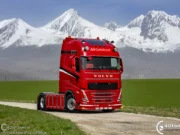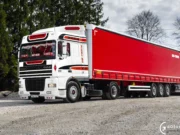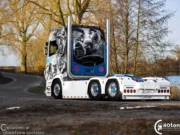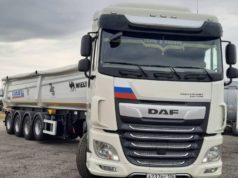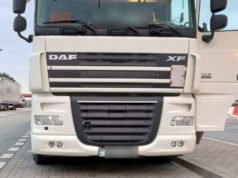
Translation: Tomasz Oryński
Polska wersja: tutaj
Convoys with humanitarian help for Ukraine can be seen nowadays all across Europe. The participants of such convoys can count on Police escort, Fire trucks from all over Europe can also be seen, and the goods are being re-loaded at the Polish border. But there is one group of unsung heroes we could only find when we look at this topic closer. Truck drivers, whose faces won’t be shown in the media – and, moreover, should not be photographed. They drive their trucks between Poland and the cities of Ukraine thanks to special permits issued to them by the Ukrainian government.
An articulated lorry, more than a dozen years old, just arrived in one of the cities in Western Poland. Just three weeks ago it would be an ordinary truck, like many others that could be seen on our roads. But on that night the sight of Ukrainian number plates means much more and the loading process also differs from the usual procedures.
The truck reversed to the rear of a small building where a group of volunteers waited. Some of them climbed the trailer, others – men and women alike – began passing boxes of humanitarian help to them. Those were donations donated by ordinary people – not only from Poland but also from Germany, the Netherlands, and even from a tiny principality of Liechtenstein.
The driver – I would give him 35 years – arrived here directly from Ukraine. He began his journey empty to avoid queuing on the Ukrainian-Polish border. He also had to show documents permitting him to leave his country in order to bring humanitarian help back, otherwise, he would not be allowed to leave, as every man in the conscription age is subject to mandatory drafting. But the Ukrainian government issue special exceptions for people like him so they can provide haulage services even more crucial now than during the time of peace.
The person who organized this shipment, whom I met during the loading of the Ukrainian truck, also insisted on some special measures. He admits that part of those humanitarian donations might end up in the wrong hands, which is nothing unheard of during military conflicts. Therefore before the driver got back into his cab, the set of seals had been placed on his vehicle, and the whole procedure was filmed with a mobile phone. When the goods reach Ukraine, a trusted co-worker on the other end will confirm the reception of the cargo in a secret, previously established way. Meanwhile, the driver had to fulfill the usual requirements of his job – a shortened, 9 hours long, daily rest period, allowing him to get at least minimal rest before heading back to his war-torn homeland.
The vehicle described here will cross the Polish-Ukrainian border without any reloading. It won’t go to Lviv either, where most of the humanitarian convoys are heading. It will head for another region of Ukraine, safe enough for the driver to go there on his own. But even that won’t be the end of his journey, as this load is destined for the people that need it the most: it is heading to Mykolaiv, a city between Odesa and Crimea, about 900 km from the Polish border. Moreover, at the time of writing, Mykolaiv is said to be the most bombarded town in the whole country. Obviously then the last leg of the journey will have to be undertaken in a completely different manner, but, of course, even there trucks and drivers will still be needed.
By the way, as I was talking with the coordinator of that transport, I asked him what kind of help they need the most. The answer was very clear: in places like Mykolaiv the most urgently needed items are medkits, bullet-proof vests, torches, or thermal clothing.



